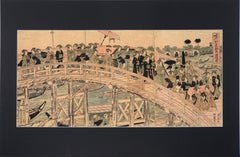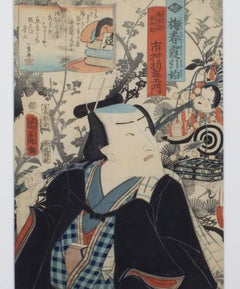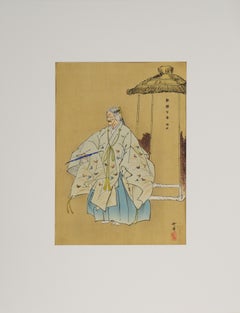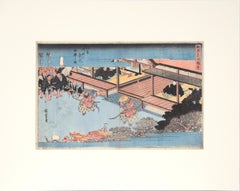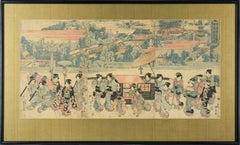Edo Prints and Multiples
to
31
38
25
4
7
1
Overall Width
to
Overall Height
to
21,262
18,251
10,600
6,193
4,875
2,668
1,560
1,412
1,350
848
827
425
348
196
7
4
3
3
2
13
51
11
5
2
13
47
28
64
46
30
20
16
13
13
10
8
8
4
3
3
3
2
2
1
1
1
1
70
59
39
36
17
25
4
71
4
Style: Edo
Mitate of a Daimyo's Procession Crossing Ryogoku Bridge - Woodblock Print
By Keisai Eisen
Located in Soquel, CA
Mitate of a Daimyo's Procession Crossing Ryogoku Bridge - Woodblock Print
Woodblock print of a procession by Keisai Eisen (Japanese, 1790–1848). Terrific triptych of a procession of...
Category
Early 19th Century Edo Prints and Multiples
Materials
Ink, Rice Paper, Woodcut
"House Cleaning in Preparation for the New Year" - Japanese Woodblock on Paper
Located in Soquel, CA
"House Cleaning in Preparation for the New Year" - Japanese Woodblock on Paper
House cleaning scene by Kitagawa Utamaro (Japanese, 1753-1806). This print was originally published around 1796-1799, with this example being a later reprint. The full scene is five sheets - there are two more sheets to the right that show more members of the house. However, it is these three sheets that contain the majority of the action - a maid sweeping at a mouse, a lady fainting, and a painting moved aside to allow for cleaning.
Presented in a new black mat.
Mat size: 24"H x 38"W
Paper size: 17.75"H x 33"W
Print Impression: 14.63"H x 29.5"W
Utamaro Kitagawa...
Category
18th Century Edo Prints and Multiples
Materials
Rice Paper, Woodcut
19th century color woodcut Japanese ukiyo-e print samurai figure
By Toyoharu Kunichika
Located in Milwaukee, WI
"Ichimura Hazaemon as Hatsuyumeya Mitsujiro" is a woodcut print by Toyoharu Kunichika in red, blue, and black.
14" x 9 1/2" art
20 3/4" x 16 3/4" framed
From the series “First Per...
Category
1860s Edo Prints and Multiples
Materials
Woodcut
One Hundred Prints Of The Noh - 1925 Original Japanese Woodblock Print
Located in Soquel, CA
One Hundred Prints Of The Noh - 1925 Original Japanese Woodblock Print
Original Japanese woodblock print by Tsukioka Kogyo (Japanese, 1869...
Category
1920s Edo Prints and Multiples
Materials
Ink, Rice Paper, Woodcut
Sumiyoshi: Dengaku dance performed during an Onda ceremony - Woodblock Print
Located in Soquel, CA
Sumiyoshi: Dengaku dance performed during an Onda ceremony - Woodblock Print
Bright woodblock print by Utagawa Hiroshige (Japanese, 1797-1858). In this scene, two dancers with swords and fans are facing each other, in the center of a courtyard. There are spectators surrounding them, including nobles in black clothing on a balcony.
Presented in a new off-white mat with foamcore backing.
Mat size: 16"H x 20"W
Paper size: 9.63"H x 14.5W"
Utagawa Hiroshige (1797-1858, sometimes called Ando Hiroshige) was the second of the two great masters of the Japanese landscape woodblock print...
Category
1830s Edo Prints and Multiples
Materials
Ink, Rice Paper, Woodcut
The Pilgrimage Procession to Kinryuzan Temple at Asakusa in the Eastern Capital
By Kuniyasu
Located in Soquel, CA
Japanese Parade - Woodblock Print
Japanese woodblock print by Utagawa Kuniyasu (歌川 国安) (Japan, 1794–1832). Japanese women, dressed in blue and red kimonos, are the focal point. A vi...
Category
Mid-19th Century Edo Prints and Multiples
Materials
Paper, Ink, Woodcut
Kabuki Actor in Blue Kimono - Original Woodblock Print
Located in Soquel, CA
Kabuki Actor in Blue Kimono - Original Woodblock Print
Original woodblock print depicting a Kabuki actor in a blue kimono by Suzuki Harunobu (Japanese, 1725-1770). The actor holds u...
Category
1760s Edo Prints and Multiples
Materials
Ink, Rice Paper, Woodcut
$1,080 Sale Price
20% Off
Actor Arashi Rikan II as Aburaya Yohei - Figurative Woodblock Print on Paper
Located in Soquel, CA
Actor Arashi Rikan II as Aburaya Yohei - Figurative Woodblock Print on Paper
Woodblock print of kabuki actor by Shunbaisai Hokuei (Japanes...
Category
1830s Edo Prints and Multiples
Materials
Paper, Ink, Woodcut
Scribe and Personal Assistant to the Shogun - Japanese Woodblock Print on Paper
Located in Soquel, CA
Scribe and Personal Assistant to the Shogun - Japanese Woodblock Print on Paper
Detailed woodblock print by an unknown artist, In the style of Suzuki Harunobu. There are two women i...
Category
19th Century Edo Prints and Multiples
Materials
Paper, Ink, Woodcut
$920 Sale Price
20% Off
Beauty on a Veranda with Fan and Mirror
Located in Fairlawn, OH
Signed: Harunobu ga
Series: Series: Eight Fashionable Parlor Views (Furyu zashiki hakkei)?
Format Japanese: chuban
Provenance:
Private Collection, Philadelphia
Collection of McCleaf
...
Category
Mid-18th Century Edo Prints and Multiples
Materials
Woodcut
Japanese Beauties Enjoy a Full Moon
Located in Burbank, CA
"Sun, Moon and Stars". Three beauties enjoy a full moon on the veranda of a teahouse or restuarant. The woman on the left kneels and adjusts her lavishly printed kimono. The beauty in the center has her hair down, and behind her is a screen against which shadows are beautifully silhouetted, which adds an air of mystery. The seated woman on the right is perhaps a geisha, as we see a shamisen lying next to her. Before her is a tray with an assortment of foods. One may surmise that the beauties are being compared to the sun, the moon, and the stars. On the left we glimpse a full moon shining over the peaceful bay, and boats at harbor. Original first edition Japanese color woodblock print triptych...
Category
1840s Edo Prints and Multiples
Materials
Mulberry Paper, Woodcut
New Year From the Series Precious Children's Games of the Five Festivals
Located in Houston, TX
Torii Kiyonaga woodblock print from the series "Prescious Children's Games of the Five Festivals." It shows five children playing with a ball and kites flying in the background. This...
Category
Early 1800s Edo Prints and Multiples
Materials
Woodcut
Umewaka Shrine in the Rain
By Kobayashi Kiyochika
Located in Burbank, CA
Umewaka Shrine, from an untitled series of prints depicting Tokyo. A woman braces her umbrella against the rain and a man waits out the storm next to his jinriksha in this view of th...
Category
1870s Edo Prints and Multiples
Materials
Handmade Paper, Mulberry Paper, Woodcut
Japanese Beauty Admiring Kirifuri Waterfall
Located in Burbank, CA
A beauty turns to admire the Kirifuri Waterfall in Nikko Province. She holds the handle of an umbrella and wears fashionable clothing that is beautifully printed. This series pairs f...
Category
1890s Edo Prints and Multiples
Materials
Handmade Paper, Mulberry Paper, Woodcut
$940 Sale Price
20% Off
The Heroine Umekawa in "Meido no Kiyaku"
Located in Fairlawn, OH
Title: The Heroine Umekawa in "Meido no Kiyaku"
Medium: Color woodcut with mica background, silver metallic pigment, and "gofun" for the snow effect
Date Of Execution: 1923
Dimension...
Category
1920s Edo Prints and Multiples
Materials
Woodcut
Edo prints and multiples for sale on 1stDibs.
Find a wide variety of authentic Edo prints and multiples available for sale on 1stDibs. Works in this style were very popular during the 21st Century and Contemporary, but contemporary artists have continued to produce works inspired by this movement. Many Pop art paintings were created by popular artists on 1stDibs, including Utagawa Kunisada (Toyokuni III), Utagawa Hiroshige (Ando Hiroshige), Toyohara Kunichika, CHIKANOBU, and Yoshu. Frequently made by artists working with Woodcut Print, and Paper and other materials, all of these pieces for sale are unique and have attracted attention over the years. Not every interior allows for large Edo prints and multiples, so small editions measuring 2.5 inches across are also available. Prices for prints and multiples made by famous or emerging artists can differ depending on medium, time period and other attributes. On 1stDibs, the price for these items starts at $175 and tops out at $12,000, while the average work sells for $900.
Recently Viewed
View AllMore Ways To Browse
Andy Warhol Coke
Andy Warhol Fish
Andy Warhol Flowers Poster
Andy Warhol Movie Poster
Architecture Prints Georgian
Bearbrick Pink
Colonial Africa Poster
Dali Milky Way
Frank Romero On Sale
Gilles Aillaud
Gregory Colbert
Gretchen Dow Simpson
Gwenda Morgan
Jean Cocteau 1957
Jim Webb
Kaws Set 2 Clean Slate
Ken Rush
Lebanon Poster
